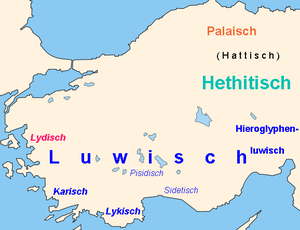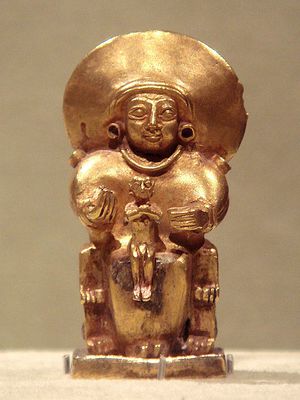「アリンナの太陽女神」の版間の差分
(→関連項目) |
|||
| (2人の利用者による、間の93版が非表示) | |||
| 1行目: | 1行目: | ||
| + | [[File:Anatolisch.png|thumb|インド・ヨーロッパ語族アナトリア語派のおおよその地理的分布。ルウィ語はアナトリア半島南部で使用されていた。]] | ||
| + | [[File:KarumKanis.png|thumb|]] | ||
| + | [[File:CuneiSun.png|thumb|「太陽神」を示す楔型文字。シュメール語の「ウトゥ」である。]] | ||
[[File:HittiteGoddessAndChildAnatolia15th-13thCenturyBCE.jpg|thumb|赤ん坊を抱いた太陽女神の像であろう、15–13th C. BC]] | [[File:HittiteGoddessAndChildAnatolia15th-13thCenturyBCE.jpg|thumb|赤ん坊を抱いた太陽女神の像であろう、15–13th C. BC]] | ||
[[File:Orthostates Alaca Hoyuk 02.jpg|thumb|アラカホユック(Alacahöyük)遺跡、太陽女神アリンナのレリーフ]] | [[File:Orthostates Alaca Hoyuk 02.jpg|thumb|アラカホユック(Alacahöyük)遺跡、太陽女神アリンナのレリーフ]] | ||
'''アリンナの太陽女神'''(Sun goddess of Arinna)は時にはアリニッティ(Arinniti)あるいはウルセム(Wuru(n)šemu)と同一視される<ref>{{Cite web|url=https://en.wikipedia.org/w/index.php?title=Arinna&oldid=875630304|title=Arinna|date=December 27, 2018|via=Wikipedia}}<!--"Arinna", December 27, 2018, Wikipediaより--></ref>。女神はヒッタイト神話の最高神で、天候神タルフンナの妻とされる。女神はヒッタイト王国の守護者で、「大地の女王」と呼ばれていた。太陽女神信仰の中心は聖なる都市アリンナだった。 | '''アリンナの太陽女神'''(Sun goddess of Arinna)は時にはアリニッティ(Arinniti)あるいはウルセム(Wuru(n)šemu)と同一視される<ref>{{Cite web|url=https://en.wikipedia.org/w/index.php?title=Arinna&oldid=875630304|title=Arinna|date=December 27, 2018|via=Wikipedia}}<!--"Arinna", December 27, 2018, Wikipediaより--></ref>。女神はヒッタイト神話の最高神で、天候神タルフンナの妻とされる。女神はヒッタイト王国の守護者で、「大地の女王」と呼ばれていた。太陽女神信仰の中心は聖なる都市アリンナだった。 | ||
| − | + | アリンナの太陽女神に加えて、ヒッタイトでは「大地の太陽女神」と「天の男性の太陽神」が信仰されていた。ルウィ人の間では、独自に古いインド・ヨーロッパ祖語の太陽神ティワズが信じられた。ヒッタイト初期の北方文化圏には、男性の太陽神は存在しなかったと思われる。<ref>Maciej Popko: ''Zur luwischen Komponente in den Religionen Altanatoliens''; AOF 34 (2007), 63–69</ref> | |
| − | |||
| − | + | 文書に遺されている様々な太陽神達は、単に楔型文字で<sup>d</sup>UTU (太陽神)としか書かれていないため、区別することが難しい。その結果、太陽神達の解釈が議論の的となっている。 | |
| − | == | + | == 家族と神話 == |
| − | + | アリンナの太陽女神と天候神タルフンナは一対の夫婦神として、共にヒッタイトの神殿の最高位を占めた。彼らの娘は[[メズラ]]といい、[[メズラ]]女神の娘はジンツヒといった。他にも都市ネリクの天候神、都市ジプランダの天候神、穀物神テリピヌが彼らの子神とされた。鷲が太陽女神の伝令とされた。 | |
| − | + | 太陽女神は、神話にほとんど登場しない。ハッティ神話の断片には、女神の住まいが都市リジナに建てられた、と記されている。別の神話には太陽女神のリンゴの木の事が書かれている。 | |
| − | {{quote| | + | {{quote|1本のリンゴの木が井戸のほとりに立っていて、血のように赤い実で覆われていた。アリンナの太陽女神はリンゴを見て、リンゴで彼女の輝く杖を飾った。|author=''KUB'' 28.6 Vs. I 10’-13’ = II 10’-13’}} |
| − | == | + | == 起源と発展 == |
| − | + | アリンナの太陽女神は元はハッティ族に起源があり、ハッティ族はエスタン(Eštan)という名で信仰していた。エスタンのハッティ族の中での通り名の一つがウルセム(「大地の母」という意味か?)だった。<ref>Jörg Klinger: ''Untersuchungen zu Rekonstruktion der hattischen Kultschicht''. Studien zu den Boǧazköy-Texten, Harrassowitz, Wiesbaden 1996, {{ISBN|3-447-03667-2}}</ref> | |
| − | + | ヒッタイト古王国の時代から、エスタンはヒッタイトの主神だった。「神の都市」であるアリンナは、最初にヒッタイトの王たちが戴冠式を挙げる場所であり、皇帝の3つの聖なる都市のうちの一つだった。女神のハッティ族の名前は、ヒッティ族のイスタヌ(Ištanu)とウルンジム(Urunzimu)という名に訳された。また、ヒッティ族は、太陽女神をアリニッティ(アリンナ神)として祈りを捧げた。「アリンナの」という通り名は、ヒッタイト中王国時代のみ、フルリ人からヒッタイトが受け入れた天の男性の太陽神と太陽女神とをはっきりと区別するために使用された。<ref>Piotr Taracha: ''Religions of Second Millennium Anatolia''. Wiesbaden 2009. {{ISBN|978-3-447-05885-8}}. S. 89</ref> | |
| − | + | ヒッタイト新王国時代、太陽女神はシリア系フルリ人の女神ヘパト(Ḫepat)と同一視され、ヒッタイト王の妃だったプドゥヘパは彼女の祈祷文の中で太陽女神のことを二つの名前で表した。 | |
| − | |||
| − | = | + | {{Quote|大地の女王にして、我が神、アリンナの太陽女神よ! ハッティの土地では、あなたは「アリンナの太陽女神」と呼ばれている。そして、レバノン杉が栄えている地ではヘパトと呼ばれています。|author=CTH 384<ref>Dietrich Sürenhagen: ''Zwei Gebete Ḫattušilis und der Puduḫepa. Textliche und literaturhistorische Untersuchungen''; [[Altorientalische Forschungen|Aof]] '''8''' (1981), pp. 83–168.</ref>}} |
| − | |||
| − | == | + | == 王権との関わり == |
| − | + | ヒッタイト古王国の時代から、アリンナの太陽女神は天候神タルフンナと共に王権を正統化する存在だった。国土は二主神に属するものとされ、太陽女神を「母」とする王が立てられた。<ref>Maciej Popko: ''Arinna. Eine heilige Stadt der Hethiter''; Studien zu den Boğazköy-Texten Bd. 50, Wiesbaden 2009. {{ISBN|978-3-447-05867-4}}. p. 28</ref> ハットゥシリ1世は膝の上に太陽女神の像を抱いていた。<ref>Volkert Haas: ''Geschichte der hethitischen Religion''; Handbuch der Orientalistik, Abt. 1, Bd. 15; Brill 1994. {{ISBN|90-04-09799-6}}. S. 585</ref>妃の何人かは、都市タルフルパで太陽女神に太陽円盤を奉納した。ヒッタイト新王国時代には、太陽女神は、女神の神官としての王と妃と共に、王国を見守っていると言われていた。ヒッタイト王は、毎日日没時に太陽女神に祈りを捧げていた。ヒッタイトの文書には、アリンナの太陽女神への多くの祈りが記されてる。最も古いものはアヌルワンダ1世から始まり、最も良く知られているのは前述のプドゥヘパ妃の祈りである。 | |
| − | + | == 信仰 == | |
| + | [[File:Turkey-kizilirmak.png|thumb|クズルウルマク川。「赤い川」という意味である。]] | ||
| + | 太陽女神の最も重要な神殿はアリンナにあった。ハットゥシャの城にも別の神殿が存在した。女神は太陽円盤として描かれた。都市タルフパでは、ヒッタイトの妃達から寄贈されたいくつかの太陽円盤が礼拝されていた。タルフンタッサのウルミ・テシュプ王は、太陽女神に一頭の牡牛と三匹の羊と共に、金、銀、銅の太陽円盤を毎年寄進した。太陽女神はしばしば女性の姿でも描かれた。光輪のある座った女神の小像も女神の姿とされたのだろう。<ref>Maciej Popko: ''Arinna. Eine heilige Stadt der Hethiter''; Studien zu den Boğazköy-Texten Bd. 50, Wiesbaden 2009. {{ISBN|978-3-447-05867-4}}. pp. 30</ref> | ||
| − | + | 鹿は太陽女神の聖獣とされ、プドゥヘパ妃は祈祷文の中で、女神に多くの鹿を奉納すると誓っている。おそらく、鹿の形をした祭祀用の器が、太陽女神の祭祀に使用されたであろう。クズルウルマク川中流域では、初期青銅器時代から金の鹿の小像が崇められており、ハッティ族の時代には太陽女神への信仰と関連づけられていた。 | |
| − | |||
| − | == | + | == イスタヌ == |
| − | * | + | イスタヌという名はハッティ族のエスタンに由来するヒッタイト語で、アリンナの太陽女神と関連している{{dubious|date=June 2018}}<!--it's just the Hittite word for "sun" and at best *also* refers to this specific goddess--><ref>Maciej Popko: ''Arinna. Eine heilige Stadt der Hethiter''; Studien zu den Boğazköy-Texten Bd. 50, Wiesbaden 2009. {{ISBN|978-3-447-05867-4}}. p. 27</ref>。始めは、イスタヌは男性の天の太陽神の名として考えられていたが<ref>Einar von Schuler: "Kleinasien: Die Mythologie der Hethiter und Hurriter," in: ''Wörterbuch der Mythologie''. Stuttgart 1965. pp. 198 f.</ref>、最近の学説ではアリンナの太陽女神を指す場合にのみ使われた名とされている<ref>Jörg Klinger: ''Untersuchungen zu Rekonstruktion der hattischen Kultschicht''; Studien zu den Boǧazköy-Texten 37, Wiesbaden 1996, {{ISBN|3-447-03667-2}}</ref>。しかし、ヴォルケルト・ハースは未だ昼間の星の象徴である男性形のイスタヌと、アリンナの太陽女神で、地下世界で夜を過ごす女性形のウルセムを区別している<ref>Volkert Haas(2011), ''Religionen des Alten Orients: Hethiter.'' Göttingen. p.226. ISBN 978-3-525-51695-9.</ref>。 |
| − | == | + | == 関連項目 == |
| + | <!--* List of solar deities--> | ||
| + | *[[ハテプナ]] | ||
| + | |||
| + | == 参考文献 == | ||
* Maciej Popko: ''Arinna. Eine heilige Stadt der Hethiter''; Studien zu den Boğazköy-Texten Vol. 50, Wiesbaden 2009. {{ISBN|978-3-447-05867-4}}. | * Maciej Popko: ''Arinna. Eine heilige Stadt der Hethiter''; Studien zu den Boğazköy-Texten Vol. 50, Wiesbaden 2009. {{ISBN|978-3-447-05867-4}}. | ||
* Volkert Haas: ''Geschichte der hethitischen Religion''; Handbuch der Orientalistik, Part 1, Vol. 15; Brill 1994. {{ISBN|90-04-09799-6}}. | * Volkert Haas: ''Geschichte der hethitischen Religion''; Handbuch der Orientalistik, Part 1, Vol. 15; Brill 1994. {{ISBN|90-04-09799-6}}. | ||
| − | == | + | == 脚注 == |
{{reflist|25em}} | {{reflist|25em}} | ||
2020年4月18日 (土) 22:45時点における最新版
アリンナの太陽女神(Sun goddess of Arinna)は時にはアリニッティ(Arinniti)あるいはウルセム(Wuru(n)šemu)と同一視される[1]。女神はヒッタイト神話の最高神で、天候神タルフンナの妻とされる。女神はヒッタイト王国の守護者で、「大地の女王」と呼ばれていた。太陽女神信仰の中心は聖なる都市アリンナだった。
アリンナの太陽女神に加えて、ヒッタイトでは「大地の太陽女神」と「天の男性の太陽神」が信仰されていた。ルウィ人の間では、独自に古いインド・ヨーロッパ祖語の太陽神ティワズが信じられた。ヒッタイト初期の北方文化圏には、男性の太陽神は存在しなかったと思われる。[2]
文書に遺されている様々な太陽神達は、単に楔型文字でdUTU (太陽神)としか書かれていないため、区別することが難しい。その結果、太陽神達の解釈が議論の的となっている。
家族と神話[編集]
アリンナの太陽女神と天候神タルフンナは一対の夫婦神として、共にヒッタイトの神殿の最高位を占めた。彼らの娘はメズラといい、メズラ女神の娘はジンツヒといった。他にも都市ネリクの天候神、都市ジプランダの天候神、穀物神テリピヌが彼らの子神とされた。鷲が太陽女神の伝令とされた。
太陽女神は、神話にほとんど登場しない。ハッティ神話の断片には、女神の住まいが都市リジナに建てられた、と記されている。別の神話には太陽女神のリンゴの木の事が書かれている。
1本のリンゴの木が井戸のほとりに立っていて、血のように赤い実で覆われていた。アリンナの太陽女神はリンゴを見て、リンゴで彼女の輝く杖を飾った。
___KUB 28.6 Vs. I 10’-13’ = II 10’-13’
起源と発展[編集]
アリンナの太陽女神は元はハッティ族に起源があり、ハッティ族はエスタン(Eštan)という名で信仰していた。エスタンのハッティ族の中での通り名の一つがウルセム(「大地の母」という意味か?)だった。[3]
ヒッタイト古王国の時代から、エスタンはヒッタイトの主神だった。「神の都市」であるアリンナは、最初にヒッタイトの王たちが戴冠式を挙げる場所であり、皇帝の3つの聖なる都市のうちの一つだった。女神のハッティ族の名前は、ヒッティ族のイスタヌ(Ištanu)とウルンジム(Urunzimu)という名に訳された。また、ヒッティ族は、太陽女神をアリニッティ(アリンナ神)として祈りを捧げた。「アリンナの」という通り名は、ヒッタイト中王国時代のみ、フルリ人からヒッタイトが受け入れた天の男性の太陽神と太陽女神とをはっきりと区別するために使用された。[4]
ヒッタイト新王国時代、太陽女神はシリア系フルリ人の女神ヘパト(Ḫepat)と同一視され、ヒッタイト王の妃だったプドゥヘパは彼女の祈祷文の中で太陽女神のことを二つの名前で表した。
大地の女王にして、我が神、アリンナの太陽女神よ! ハッティの土地では、あなたは「アリンナの太陽女神」と呼ばれている。そして、レバノン杉が栄えている地ではヘパトと呼ばれています。
___CTH 384[5]
王権との関わり[編集]
ヒッタイト古王国の時代から、アリンナの太陽女神は天候神タルフンナと共に王権を正統化する存在だった。国土は二主神に属するものとされ、太陽女神を「母」とする王が立てられた。[6] ハットゥシリ1世は膝の上に太陽女神の像を抱いていた。[7]妃の何人かは、都市タルフルパで太陽女神に太陽円盤を奉納した。ヒッタイト新王国時代には、太陽女神は、女神の神官としての王と妃と共に、王国を見守っていると言われていた。ヒッタイト王は、毎日日没時に太陽女神に祈りを捧げていた。ヒッタイトの文書には、アリンナの太陽女神への多くの祈りが記されてる。最も古いものはアヌルワンダ1世から始まり、最も良く知られているのは前述のプドゥヘパ妃の祈りである。
信仰[編集]
太陽女神の最も重要な神殿はアリンナにあった。ハットゥシャの城にも別の神殿が存在した。女神は太陽円盤として描かれた。都市タルフパでは、ヒッタイトの妃達から寄贈されたいくつかの太陽円盤が礼拝されていた。タルフンタッサのウルミ・テシュプ王は、太陽女神に一頭の牡牛と三匹の羊と共に、金、銀、銅の太陽円盤を毎年寄進した。太陽女神はしばしば女性の姿でも描かれた。光輪のある座った女神の小像も女神の姿とされたのだろう。[8]
鹿は太陽女神の聖獣とされ、プドゥヘパ妃は祈祷文の中で、女神に多くの鹿を奉納すると誓っている。おそらく、鹿の形をした祭祀用の器が、太陽女神の祭祀に使用されたであろう。クズルウルマク川中流域では、初期青銅器時代から金の鹿の小像が崇められており、ハッティ族の時代には太陽女神への信仰と関連づけられていた。
イスタヌ[編集]
イスタヌという名はハッティ族のエスタンに由来するヒッタイト語で、アリンナの太陽女神と関連している[疑問?][9]。始めは、イスタヌは男性の天の太陽神の名として考えられていたが[10]、最近の学説ではアリンナの太陽女神を指す場合にのみ使われた名とされている[11]。しかし、ヴォルケルト・ハースは未だ昼間の星の象徴である男性形のイスタヌと、アリンナの太陽女神で、地下世界で夜を過ごす女性形のウルセムを区別している[12]。
関連項目[編集]
参考文献[編集]
- Maciej Popko: Arinna. Eine heilige Stadt der Hethiter; Studien zu den Boğazköy-Texten Vol. 50, Wiesbaden 2009. ISBN 978-3-447-05867-4.
- Volkert Haas: Geschichte der hethitischen Religion; Handbuch der Orientalistik, Part 1, Vol. 15; Brill 1994. ISBN 90-04-09799-6.
脚注[編集]
- ↑ Arinna.December 27, 2018 - via Wikipedia.
- ↑ Maciej Popko: Zur luwischen Komponente in den Religionen Altanatoliens; AOF 34 (2007), 63–69
- ↑ Jörg Klinger: Untersuchungen zu Rekonstruktion der hattischen Kultschicht. Studien zu den Boǧazköy-Texten, Harrassowitz, Wiesbaden 1996, ISBN 3-447-03667-2
- ↑ Piotr Taracha: Religions of Second Millennium Anatolia. Wiesbaden 2009. ISBN 978-3-447-05885-8. S. 89
- ↑ Dietrich Sürenhagen: Zwei Gebete Ḫattušilis und der Puduḫepa. Textliche und literaturhistorische Untersuchungen; Aof 8 (1981), pp. 83–168.
- ↑ Maciej Popko: Arinna. Eine heilige Stadt der Hethiter; Studien zu den Boğazköy-Texten Bd. 50, Wiesbaden 2009. ISBN 978-3-447-05867-4. p. 28
- ↑ Volkert Haas: Geschichte der hethitischen Religion; Handbuch der Orientalistik, Abt. 1, Bd. 15; Brill 1994. ISBN 90-04-09799-6. S. 585
- ↑ Maciej Popko: Arinna. Eine heilige Stadt der Hethiter; Studien zu den Boğazköy-Texten Bd. 50, Wiesbaden 2009. ISBN 978-3-447-05867-4. pp. 30
- ↑ Maciej Popko: Arinna. Eine heilige Stadt der Hethiter; Studien zu den Boğazköy-Texten Bd. 50, Wiesbaden 2009. ISBN 978-3-447-05867-4. p. 27
- ↑ Einar von Schuler: "Kleinasien: Die Mythologie der Hethiter und Hurriter," in: Wörterbuch der Mythologie. Stuttgart 1965. pp. 198 f.
- ↑ Jörg Klinger: Untersuchungen zu Rekonstruktion der hattischen Kultschicht; Studien zu den Boǧazköy-Texten 37, Wiesbaden 1996, ISBN 3-447-03667-2
- ↑ Volkert Haas(2011), Religionen des Alten Orients: Hethiter. Göttingen. p.226. ISBN 978-3-525-51695-9.





